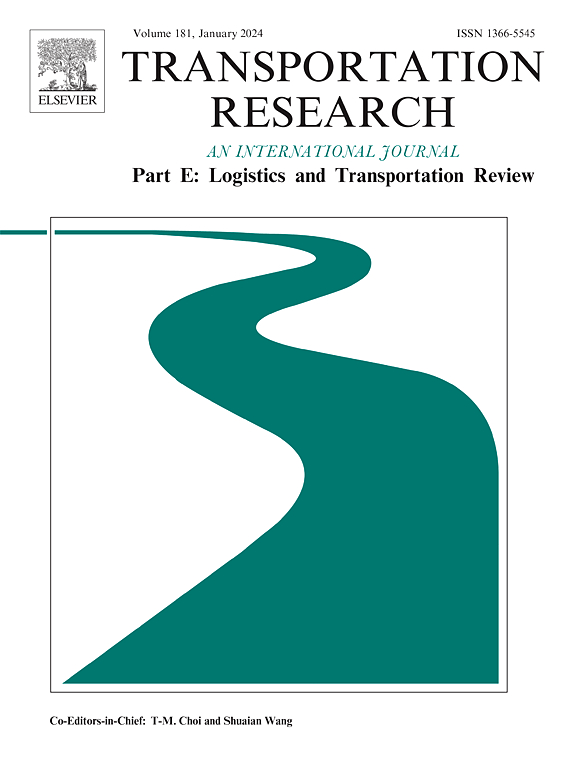Optimizing land-air collaborative operations with environmental considerations
IF 8.3
1区 工程技术
Q1 ECONOMICS
Transportation Research Part E-Logistics and Transportation Review
Pub Date : 2025-07-19
DOI:10.1016/j.tre.2025.104301
引用次数: 0
Abstract
Urban air mobility (UAM) is an emerging transportation concept with the potential to transform urban commuting. By utilizing low-altitude airspace, novel aerial vehicles can provide faster transportation between vertiports in urban and suburban areas, offering a more efficient alternative than traditional surface transport. To successfully integrate UAM into urban environments, it is crucial to effectively connect it with existing road transportation systems, particularly in terms of constructing essential ground infrastructure, such as vertiports. This paper proposes a land-air collaborative network design model that incorporates environmental considerations. Specifically, we develop a bi-objective bi-level programming model to optimize the land-air integrated operations. The upper-level authority aims to minimize both the total travel time of the system and airborne pollutant emissions during UAM operations by selecting the locations and capacities of vertiports. The lower-level model determines the route choices of the multi-class commuters based on the user equilibrium condition. To solve this model, we propose a mixed-integer Bayesian optimization approach, incorporating a path-based solution algorithm using the partial linearization descent method to address the lower-level model. Numerical experiments demonstrate that incorporating environmental considerations significantly influences the design of the land-air collaborative network. In particular, environmental factors play a critical role in shaping commuters’ route choice, which in turn substantially affects key system metrics such as vertiport capacity, total travel time, and air pollutant emissions. This study offers valuable insights into optimizing land-air collaborative operations, maximizing the operational benefits of UAM while minimizing its environmental impact.
考虑环境因素,优化陆空协同作战
城市空中交通(UAM)是一种新兴的交通概念,有可能改变城市通勤。通过利用低空空域,新型飞行器可以在城市和郊区的垂直机场之间提供更快的运输,提供比传统地面运输更有效的替代方案。要成功地将UAM融入城市环境,关键是要有效地将其与现有的道路交通系统连接起来,特别是在建设重要的地面基础设施方面,如垂直机场。本文提出了一种考虑环境因素的陆空协同网络设计模型。具体而言,我们建立了一个双目标双层次规划模型来优化陆空一体化作战。上级主管部门的目标是通过选择垂直机场的位置和容量,最大限度地减少系统的总运行时间和UAM运行期间的空气污染物排放。下层模型基于用户均衡条件确定多班次通勤者的路线选择。为了解决这个模型,我们提出了一种混合整数贝叶斯优化方法,结合了基于路径的解决算法,使用部分线性化下降方法来解决较低层次的模型。数值实验表明,考虑环境因素对陆空协同网络的设计有显著影响。特别是,环境因素在塑造通勤者的路线选择中起着关键作用,这反过来又极大地影响了关键的系统指标,如垂直机场容量、总旅行时间和空气污染物排放。这项研究为优化陆空协同作战,最大化UAM的运营效益,同时最大限度地减少其对环境的影响提供了有价值的见解。
本文章由计算机程序翻译,如有差异,请以英文原文为准。
求助全文
约1分钟内获得全文
求助全文
来源期刊
CiteScore
16.20
自引率
16.00%
发文量
285
审稿时长
62 days
期刊介绍:
Transportation Research Part E: Logistics and Transportation Review is a reputable journal that publishes high-quality articles covering a wide range of topics in the field of logistics and transportation research. The journal welcomes submissions on various subjects, including transport economics, transport infrastructure and investment appraisal, evaluation of public policies related to transportation, empirical and analytical studies of logistics management practices and performance, logistics and operations models, and logistics and supply chain management.
Part E aims to provide informative and well-researched articles that contribute to the understanding and advancement of the field. The content of the journal is complementary to other prestigious journals in transportation research, such as Transportation Research Part A: Policy and Practice, Part B: Methodological, Part C: Emerging Technologies, Part D: Transport and Environment, and Part F: Traffic Psychology and Behaviour. Together, these journals form a comprehensive and cohesive reference for current research in transportation science.

 求助内容:
求助内容: 应助结果提醒方式:
应助结果提醒方式:


